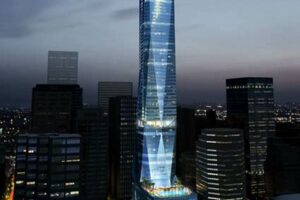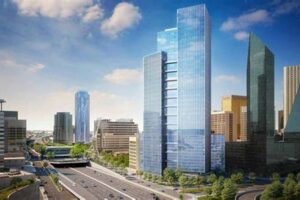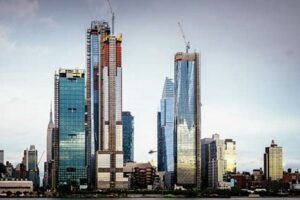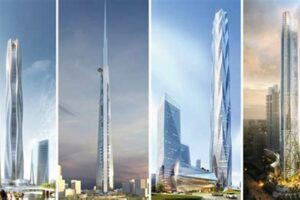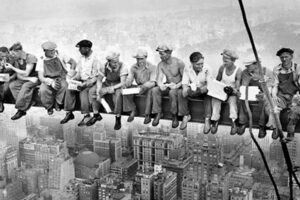Skyscrapers under construction are incomplete high-rise buildings still undergoing construction. They stand as impressive urban landmarks during their development, symbolizing progress, architectural prowess, and the evolution of city skylines.
The construction of skyscrapers involves complex engineering, skilled labor, and innovative techniques to ensure structural integrity and architectural grandeur. These buildings often push architectural boundaries, showcasing unique designs and sustainable features. Their construction provides employment opportunities, contributes to economic growth, and enhances the urban landscape.
As we delve into the main article, we will explore the fascinating world of skyscrapers under construction, examining their architectural significance, construction processes, and impact on urban development.
1. Engineering Marvels
Skyscrapers under construction epitomize engineering marvels, showcasing extraordinary feats of structural design and construction techniques. These architectural wonders push the boundaries of engineering innovation, employing cutting-edge technologies to achieve unprecedented heights and complex forms.
- Structural Ingenuity
Skyscrapers rely on innovative structural systems to withstand immense weight and lateral forces. Engineers employ advanced materials like reinforced concrete, steel, and composite structures to create strong and resilient frameworks.
- Wind Engineering
High-rise buildings are susceptible to wind forces that can cause swaying and instability. Engineers conduct extensive wind tunnel testing and employ aerodynamic designs to mitigate these effects, ensuring structural integrity.
- Foundation Systems
The foundation of a skyscraper is crucial for stability and load-bearing capacity. Engineers design deep foundations, such as pile foundations or caissons, to transfer the building’s weight to stable soil layers.
- Construction Techniques
Skyscrapers require specialized construction techniques to assemble their massive components and reach towering heights. Engineers utilize advanced equipment, such as tower cranes and slip-form construction, to efficiently and safely erect these structures.
These engineering marvels are testaments to human ingenuity and the relentless pursuit of architectural advancements. Skyscrapers under construction represent the pinnacle of structural engineering, pushing the limits of what is possible and reshaping the urban landscape.
2. Architectural Innovation
Skyscrapers under construction are canvases for architectural innovation, where visionary designs and cutting-edge technologies converge to redefine urban skylines. Architectural innovation in this context encompasses the exploration of novel forms, sustainable materials, and energy-efficient systems to create iconic and functional high-rise structures.
The drive for architectural innovation in skyscrapers stems from the desire to push the boundaries of design and functionality. Architects experiment with unconventional shapes, such as twisted towers and asymmetrical facades, to create striking visual statements. They incorporate innovative materials like glass, steel, and composite panels to enhance structural performance and reduce environmental impact.
Sustainability is a key driver of architectural innovation in skyscrapers under construction. Architects employ green building practices to minimize energy consumption and reduce carbon emissions. They design skyscrapers with energy-efficient lighting systems, rainwater harvesting systems, and solar panels to promote environmental sustainability.
Architectural innovation in skyscrapers has practical significance beyond aesthetics and sustainability. Innovative designs can improve building performance, reduce construction costs, and enhance occupant well-being. For example, double-skin facades provide insulation and natural ventilation, reducing energy consumption and improving indoor air quality.
In conclusion, architectural innovation is an integral part of skyscrapers under construction, shaping their design, functionality, and environmental impact. By embracing innovative concepts and technologies, architects create high-rise structures that are not only visually stunning but also sustainable, efficient, and responsive to the needs of modern society.
3. Economic Drivers
Skyscrapers under construction serve as potent economic drivers, contributing to urban growth and prosperity in numerous ways. Their development stimulates job creation, boosts real estate values, and attracts businesses and investments.
During the construction phase, skyscrapers generate significant employment opportunities for architects, engineers, construction workers, and various skilled laborers. These jobs provide income and support local economies. Moreover, the influx of construction workers and materials creates demand for housing, transportation, and other services, further stimulating economic activity.
Upon completion, skyscrapers become valuable assets that attract businesses and investments to urban centers. High-rise office buildings provide premium commercial space for corporations, financial institutions, and professional firms. Residential skyscrapers offer luxurious living accommodations, boosting real estate values and generating tax revenue for municipalities.
Skyscrapers also serve as catalysts for urban renewal and infrastructure development. Their construction often triggers investments in public transportation, parks, and other amenities, enhancing the overall quality of life in the surrounding areas. Moreover, skyscrapers can attract tourists and generate revenue through hospitality and retail businesses.
Understanding the connection between economic drivers and skyscrapers under construction is crucial for urban planners and policymakers. By leveraging the economic benefits of high-rise development, cities can attract investment, create jobs, and foster economic growth.
4. Urban Transformation
Skyscrapers under construction serve as powerful catalysts for urban transformation, reshaping city skylines, driving economic growth, and enhancing the quality of urban life. Their development triggers a ripple effect of changes that redefine the fabric and functionality of cities.
- Redefining skylines
Skyscrapers under construction alter the physical landscape of cities, creating new landmarks and reshaping skylines. They introduce verticality and density, transforming urban panoramas and contributing to the city’s unique identity.
- Economic revitalization
The construction and presence of skyscrapers stimulate economic growth by attracting businesses, investments, and skilled workers. They create employment opportunities and boost real estate values, leading to increased tax revenue for municipalities.
- Improved infrastructure
Skyscrapers under construction often trigger investments in public transportation, road networks, and other infrastructure to support the influx of people and businesses. This improved connectivity enhances the overall accessibility and livability of the city.
- Cultural vibrancy
Skyscrapers can serve as cultural landmarks and attract tourists. They may house museums, art galleries, or observation decks, creating new destinations and enriching the cultural fabric of the city.
The connection between urban transformation and skyscrapers under construction is undeniable. These high-rise structures are not merely architectural marvels but also powerful agents of change that reshape cities, drive economic growth, and enhance urban life. Understanding this connection is crucial for urban planners and policymakers seeking to harness the transformative potential of skyscrapers for sustainable and vibrant cities.
5. Sustainability and Efficiency
The pursuit of sustainability and efficiency is an integral aspect of skyscraper construction and design. As cities strive to reduce their environmental impact and optimize resource usage, skyscrapers are increasingly incorporating sustainable practices and energy-efficient technologies to meet these demands. This focus on sustainability and efficiency extends beyond environmental concerns and encompasses economic and social considerations, making it a crucial component of skyscraper development.
One key aspect of sustainability in skyscrapers is reducing energy consumption. Architects and engineers employ various strategies to achieve this, such as using energy-efficient lighting systems, installing solar panels to harness renewable energy, and implementing smart building technologies to optimize energy usage. Efficient building insulation and high-performance glazing help minimize heat loss and reduce the need for heating and cooling systems.
Water conservation is another important aspect of sustainable skyscraper design. Low-flow fixtures, rainwater harvesting systems, and drought-tolerant landscaping contribute to reducing water consumption and promoting water sustainability. Additionally, skyscrapers can incorporate green roofs and vertical gardens, which provide insulation, improve air quality, and reduce the urban heat island effect.
Beyond environmental sustainability, energy efficiency also translates to economic benefits for building owners and occupants. Lower energy consumption leads to reduced operating costs, increased property value, and improved tenant satisfaction. Moreover, sustainable skyscrapers often qualify for green building certifications, which can provide financial incentives and recognition for their environmental performance.
The connection between sustainability and efficiency in skyscrapers under construction is vital for creating environmentally responsible and economically viable urban environments. By adopting sustainable practices and energy-efficient measures, skyscrapers can minimize their ecological footprint, reduce operating costs, and contribute to the overall sustainability of cities.
6. Construction Challenges
Skyscrapers under construction present unique and formidable challenges that require innovative solutions and meticulous execution. These challenges arise from various factors, including the sheer scale of these structures, the complexity of their designs, and the need to adhere to strict safety regulations. Overcoming these challenges is essential for ensuring the structural integrity, functionality, and safety of these architectural marvels.
- Engineering Complexity
Skyscrapers, with their towering heights and intricate designs, demand exceptional engineering prowess. Engineers must carefully consider factors such as wind loads, seismic activity, and material properties to design a structure that can withstand various forces and environmental conditions.
- Logistical Coordination
The construction of skyscrapers involves a complex web of logistics, including coordinating the transportation and assembly of massive components, managing a large workforce, and ensuring a steady supply of materials. Effective coordination is crucial to maintain the project timeline and ensure the safety of workers.
- Height-Related Hazards
Working at extreme heights poses inherent risks to construction workers. Strong winds, exposure to weather elements, and the need for specialized equipment can create hazardous conditions. Implementing robust safety measures, such as fall protection systems and proper training, is essential to mitigate these risks.
- Foundation and Geotechnical Considerations
The immense weight of skyscrapers demands solid and stable foundations. Geotechnical engineers must carefully analyze soil conditions and design appropriate foundation systems, such as deep pile foundations or reinforced concrete mats, to ensure the stability of the structure.
Addressing these construction challenges requires collaboration between architects, engineers, contractors, and safety professionals. By leveraging advanced technologies, implementing innovative techniques, and adhering to stringent safety protocols, these challenges can be effectively overcome, paving the way for the successful construction of skyscrapers that redefine skylines and push the boundaries of architectural ingenuity.
7. Safety and Labor
In the realm of skyscraper construction, safety and labor take center stage, as these towering structures demand meticulous attention to detail and a highly skilled workforce. Ensuring the well-being of construction workers and maintaining a safe working environment are paramount, while labor practices play a crucial role in the successful execution of these ambitious projects.
- Height-Related Hazards and Mitigation Strategies
Skyscraper construction involves inherent height-related hazards, such as falls, exposure to strong winds, and inclement weather conditions. To mitigate these risks, comprehensive safety measures are implemented, including the use of personal protective equipment, fall arrest systems, and proper training for workers. Regular safety inspections and adherence to industry standards help ensure a safe working environment.
- Skilled Workforce and Specialized Training
The construction of skyscrapers requires a highly skilled workforce proficient in various trades, such as ironworkers, concrete finishers, and crane operators. Specialized training programs and apprenticeship opportunities are essential to equip workers with the knowledge and expertise necessary to perform their tasks safely and efficiently. Continuous training helps workers stay abreast of the latest safety regulations and best practices.
- Labor Coordination and Communication
Skyscraper construction involves a complex interplay between different teams of workers, each responsible for specific tasks. Effective labor coordination and communication are vital to ensure a smooth workflow, minimize delays, and prevent accidents. Clear communication channels, regular safety briefings, and well-defined roles and responsibilities contribute to a well-coordinated and safe working environment.
- Employee Well-being and Support
Recognizing the demanding nature of skyscraper construction, it is essential to prioritize the well-being of workers. Providing adequate rest periods, access to healthcare facilities, and mental health support can help prevent burnout and promote a positive work environment. Additionally, fair wages, benefits, and opportunities for career advancement contribute to employee satisfaction and retention.
The nexus between safety and labor in skyscraper construction underscores the importance of creating a work environment that prioritizes the well-being of workers while fostering a culture of safety and collaboration. By investing in safety measures, training programs, and employee support, construction companies can enhance productivity, reduce risks, and ensure the successful completion of these architectural marvels.
8. Cultural Significance
Skyscrapers under construction are not just engineering marvels but also cultural landmarks that shape the identity and aspirations of cities. They transcend their functional purpose and become symbols of progress, economic power, and architectural innovation. Exploring the cultural significance of skyscrapers under construction reveals the multifaceted ways these structures impact our societies.
- Icons of Urban Identity
Skyscrapers become iconic representations of cities, defining their skylines and serving as landmarks that embody the city’s character. The Empire State Building in New York City, the Petronas Towers in Kuala Lumpur, and the Burj Khalifa in Dubai are just a few examples of skyscrapers that have become synonymous with their respective cities.
- Symbols of Economic Prosperity
Skyscrapers are often associated with economic growth and prosperity. The construction of skyscrapers is often seen as a sign of a city’s economic vitality and ambition. For example, the rapid construction of skyscrapers in cities like Shanghai and Dubai has been closely tied to their booming economies.
- Expressions of Architectural Innovation
Skyscrapers push the boundaries of architectural design and engineering. They showcase innovative structural systems, novel building materials, and sustainable technologies. The construction of skyscrapers often involves collaborations between architects, engineers, and construction companies, resulting in unique and groundbreaking architectural achievements.
- Reflection of Social and Cultural Values
Skyscrapers can reflect the social and cultural values of a particular time and place. For example, the construction of skyscrapers during the Art Deco period in the early 20th century reflected the optimism and technological advancements of that era. Similarly, the focus on sustainable and energy-efficient skyscrapers in recent years reflects growing environmental concerns and the pursuit of sustainable development.
In conclusion, the cultural significance of skyscrapers under construction is multifaceted and profound. These structures are more than just buildings; they are symbols of urban identity, economic prosperity, architectural innovation, and social and cultural values. Understanding and appreciating their cultural significance helps us gain a deeper understanding of the cities we live in and the societies we build.
9. Future of Skylines
Skyscrapers under construction are not just physical structures; they are harbingers of the future, shaping the skylines and identities of cities in profound ways. As we look ahead, the future of skylines is intricately connected to the innovative designs, sustainable practices, and technological advancements that are defining skyscraper construction today.
- Vertical Urbanism
Skyscrapers are enabling a new era of vertical urbanism, where cities are expanding upwards rather than outwards. This trend is driven by factors such as increasing population density, land scarcity, and a desire for more sustainable and efficient urban environments. Skyscrapers under construction are pushing the boundaries of vertical living, incorporating residential, commercial, and public spaces into a single high-rise structure.
- Sustainable Skylines
The future of skylines is characterized by a strong emphasis on sustainability. Skyscrapers under construction are increasingly incorporating green building technologies, renewable energy sources, and energy-efficient designs to reduce their environmental impact. These sustainable practices are not only environmentally responsible but also economically beneficial, as they can lower operating costs and increase the value of buildings.
- Smart and Connected Buildings
Skyscrapers of the future will be smart and connected, leveraging technology to enhance building performance, occupant comfort, and urban connectivity. Building management systems, smart sensors, and Internet of Things (IoT) devices will allow for real-time monitoring and control of building systems, optimizing energy usage, improving indoor air quality, and providing personalized services to occupants. These smart features will transform skyscrapers into hubs of innovation and efficiency.
- Mixed-Use Developments
Skyscrapers under construction are increasingly incorporating mixed-use developments, combining residential, commercial, retail, and public spaces within a single building. This trend promotes walkability, reduces traffic congestion, and fosters vibrant urban communities. Mixed-use skyscrapers create diverse and dynamic neighborhoods where people can live, work, shop, and socialize without having to travel far distances.
These facets of the future of skylines, as evident in skyscrapers under construction, point towards a future where cities are more sustainable, efficient, and connected. By embracing innovative designs, sustainable practices, and smart technologies, skyscrapers are not only reshaping skylines but also transforming the way we live, work, and interact with our urban environments.
Skyscrapers Under Construction
This section addresses commonly asked questions and misconceptions regarding skyscrapers under construction, providing clear and informative answers.
Question 1: What are the key safety measures implemented during skyscraper construction?
Skyscraper construction prioritizes safety through comprehensive measures such as personal protective equipment, fall arrest systems, regular safety inspections, and adherence to industry standards. These measures ensure a safe working environment for construction workers at great heights.
Question 2: How do skyscrapers withstand strong winds and seismic activity?
Skyscrapers employ advanced engineering techniques to resist lateral forces caused by wind and earthquakes. Structural systems like reinforced concrete cores, steel frames, and outrigger trusses work together to distribute and absorb these forces, ensuring the stability and integrity of the building.
Question 3: What are the environmental considerations in modern skyscraper construction?
Sustainability plays a crucial role in skyscraper construction today. Green building practices include energy-efficient lighting, renewable energy sources like solar panels, low-flow fixtures, and rainwater harvesting systems. These measures aim to reduce the environmental impact of skyscrapers and promote sustainable urban development.
Question 4: How do skyscrapers contribute to urban development?
Skyscrapers act as catalysts for urban transformation, attracting businesses, investments, and skilled workers. They stimulate economic growth, improve infrastructure, and create vibrant urban centers. Additionally, skyscrapers can serve as cultural landmarks and tourist destinations, enriching the cultural fabric of cities.
Question 5: What innovative technologies are shaping the future of skyscraper construction?
Advancements in technology are revolutionizing skyscraper construction. Building information modeling (BIM) enhances design collaboration and efficiency. Smart sensors and IoT devices enable real-time monitoring and optimization of building systems. Prefabrication and modular construction techniques improve safety, reduce construction time, and promote sustainability.
Question 6: How do skyscrapers impact the surrounding urban environment?
Skyscrapers can have both positive and negative effects on their surroundings. They can cast shadows on nearby buildings, affect wind patterns, and contribute to increased air pollution if energy-efficient measures are not implemented. However, skyscrapers can also improve urban density, promote walkability, and create green spaces at ground level, contributing to a more sustainable and livable urban environment.
In summary, skyscrapers under construction are marvels of engineering and architectural innovation that contribute to the growth and transformation of cities. Understanding the safety measures, engineering principles, sustainability practices, and technological advancements involved in their construction helps us appreciate their significance and the impact they have on our urban environments.
Transition to the next article section: Exploring the Architectural Significance of Skyscrapers Under Construction
Tips for Skyscraper Construction
Skyscraper construction is a complex and challenging endeavor that requires careful planning, engineering expertise, and adherence to safety protocols. By following these tips, construction teams can increase efficiency, ensure safety, and deliver high-quality skyscrapers that will stand the test of time.
Tip 1: Prioritize Safety Throughout the Process
Safety should be the top priority at every stage of skyscraper construction. Implement comprehensive safety measures such as fall protection systems, proper training for workers, and regular safety inspections to minimize risks and ensure the well-being of construction personnel.
Tip 2: Leverage Advanced Engineering Techniques
Skyscrapers are subjected to various forces, including wind, earthquakes, and gravity. Employ innovative engineering techniques such as reinforced concrete cores, steel frames, and outrigger trusses to ensure structural stability and integrity, mitigating the impact of these forces.
Tip 3: Incorporate Sustainable Practices
Incorporate green building practices to reduce the environmental impact of skyscrapers. Use energy-efficient lighting, install solar panels, implement rainwater harvesting systems, and opt for low-flow fixtures to promote sustainability and minimize operating costs.
Tip 4: Utilize Technology to Enhance Efficiency
Embrace technological advancements to improve efficiency and safety during skyscraper construction. Building information modeling (BIM) can enhance design collaboration and reduce errors. Smart sensors and IoT devices enable real-time monitoring of building systems, optimizing performance and preventing issues.
Tip 5: Pay Attention to Urban Context
Consider the surrounding urban environment when designing and constructing skyscrapers. Minimize the impact on neighboring buildings by carefully managing shadows and wind patterns. Create green spaces at ground level to enhance the livability and aesthetics of the urban landscape.
Summary
By adhering to these tips, construction teams can successfully navigate the complexities of skyscraper construction, ensuring safety, efficiency, and sustainability. These architectural marvels will continue to shape skylines and serve as symbols of human ingenuity and urban progress.
Conclusion
Skyscrapers under construction are not merely structures of steel and glass; they are testaments to human ambition, engineering prowess, and architectural ingenuity. Their construction is a complex and fascinating process that involves overcoming numerous challenges and implementing innovative solutions.
This article has explored various aspects of skyscrapers under construction, from their engineering marvels and architectural significance to their impact on urban development and the future of skylines. These structures are not just vertical extensions of our cities; they are symbols of progress, economic vitality, and cultural identity.
As we continue to push the boundaries of architectural design and construction techniques, skyscrapers will undoubtedly continue to redefine our skylines and shape the way we live, work, and interact with our urban environments. Their presence serves as a reminder of human ingenuity and our relentless pursuit of architectural excellence.


